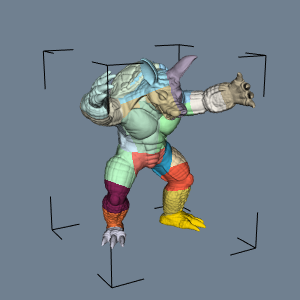OBBDicer
Repository source: OBBDicer
Description¶
The vtkOBBDicer filter breaks up an input mesh into a number of pieces. The resulting mesh contains scalar point data that can be used to extract the individual pieces with a filter like vtkThresholdFilter. This examples displays the output of vtkOBBDicer with a different color for each piece.
The first argument is a filename for a vtkPolyData reader. If not specified, then a vtkSphereSource generates the vtkPolyData. The second argument is the number of pieces and is optional. The default is 4.
The example was run with these arguments:
OBBDicer Armadillo.ply 20
Other languages
See (PythonicAPI), (CSharp)
Question
If you have a question about this example, please use the VTK Discourse Forum
Code¶
OBBDicer.cxx
#include <vtkActor.h>
#include <vtkCamera.h>
#include <vtkLookupTable.h>
#include <vtkMinimalStandardRandomSequence.h>
#include <vtkNamedColors.h>
#include <vtkNew.h>
#include <vtkOBBDicer.h>
#include <vtkOutlineCornerFilter.h>
#include <vtkPolyDataMapper.h>
#include <vtkProperty.h>
#include <vtkRenderWindow.h>
#include <vtkRenderWindowInteractor.h>
#include <vtkRenderer.h>
#include <vtkBYUReader.h>
#include <vtkOBJReader.h>
#include <vtkPLYReader.h>
#include <vtkPolyDataReader.h>
#include <vtkSTLReader.h>
#include <vtkSphereSource.h>
#include <vtkXMLPolyDataReader.h>
#include <vtksys/SystemTools.hxx>
#include <array>
#include <iostream>
namespace {
vtkSmartPointer<vtkPolyData> ReadPolyData(const char* fileName);
}
int main(int argc, char* argv[])
{
auto pieces = 4;
if (argc > 2)
{
pieces = std::atoi(argv[2]);
}
auto inputPolyData = ReadPolyData(argc > 1 ? argv[1] : "");
// Create pipeline
vtkNew<vtkOBBDicer> dicer;
dicer->SetInputData(inputPolyData);
dicer->SetNumberOfPieces(pieces);
dicer->SetDiceModeToSpecifiedNumberOfPieces();
dicer->Update();
int numberOfRegions = dicer->GetNumberOfActualPieces();
// Fill in a few known colors, the rest will be generated if needed.
vtkNew<vtkNamedColors> colors;
vtkNew<vtkLookupTable> lut;
lut->SetNumberOfTableValues(std::max(numberOfRegions, 10));
lut->Build();
lut->SetTableValue(0, colors->GetColor4d("Gold").GetData());
lut->SetTableValue(1, colors->GetColor4d("Banana").GetData());
lut->SetTableValue(2, colors->GetColor4d("Tomato").GetData());
lut->SetTableValue(3, colors->GetColor4d("Wheat").GetData());
lut->SetTableValue(4, colors->GetColor4d("Lavender").GetData());
lut->SetTableValue(5, colors->GetColor4d("Flesh").GetData());
lut->SetTableValue(6, colors->GetColor4d("Raspberry").GetData());
lut->SetTableValue(7, colors->GetColor4d("Salmon").GetData());
lut->SetTableValue(8, colors->GetColor4d("Mint").GetData());
lut->SetTableValue(9, colors->GetColor4d("Peacock").GetData());
// If the number of regions is larger than the number of specified colors,
// generate some random colors.
if (numberOfRegions > 9)
{
vtkNew<vtkMinimalStandardRandomSequence> rng;
rng->SetSeed(8775070);
std::array<double, 2> value_range{0.6, 1.0};
for (auto i = 10; i < numberOfRegions; ++i)
{
auto r = rng->GetRangeValue(value_range[0], value_range[1]);
rng->Next();
auto g = rng->GetRangeValue(value_range[0], value_range[1]);
rng->Next();
auto b = rng->GetRangeValue(value_range[0], value_range[1]);
rng->Next();
lut->SetTableValue(i, r, g, b, 1.0);
}
}
vtkNew<vtkPolyDataMapper> inputMapper;
inputMapper->SetInputConnection(dicer->GetOutputPort());
inputMapper->SetScalarRange(0, dicer->GetNumberOfActualPieces());
inputMapper->SetLookupTable(lut);
std::cout << "Asked for: " << dicer->GetNumberOfPieces()
<< " pieces, got: " << dicer->GetNumberOfActualPieces()
<< std::endl;
vtkNew<vtkActor> inputActor;
inputActor->SetMapper(inputMapper);
inputActor->GetProperty()->SetInterpolationToFlat();
vtkNew<vtkOutlineCornerFilter> outline;
outline->SetInputData(inputPolyData);
vtkNew<vtkPolyDataMapper> outlineMapper;
outlineMapper->SetInputConnection(outline->GetOutputPort());
vtkNew<vtkActor> outlineActor;
outlineActor->SetMapper(outlineMapper);
outlineActor->GetProperty()->SetColor(colors->GetColor3d("Black").GetData());
vtkNew<vtkRenderer> renderer;
renderer->UseHiddenLineRemovalOn();
vtkNew<vtkRenderWindow> renderWindow;
renderWindow->AddRenderer(renderer);
renderWindow->SetWindowName("OBBDicer");
vtkNew<vtkRenderWindowInteractor> interactor;
interactor->SetRenderWindow(renderWindow);
// Add the actors to the renderer, set the background and size.
renderer->AddActor(outlineActor);
renderer->AddActor(inputActor);
renderer->SetBackground(colors->GetColor3d("SlateGray").GetData());
renderer->GetActiveCamera()->Azimuth(150);
renderer->GetActiveCamera()->Elevation(15);
renderer->ResetCamera();
// Render the image
renderWindow->Render();
interactor->Start();
return EXIT_SUCCESS;
}
namespace {
vtkSmartPointer<vtkPolyData> ReadPolyData(const char* fileName)
{
vtkSmartPointer<vtkPolyData> polyData;
std::string extension =
vtksys::SystemTools::GetFilenameExtension(std::string(fileName));
if (extension == ".ply")
{
vtkNew<vtkPLYReader> reader;
reader->SetFileName(fileName);
reader->Update();
polyData = reader->GetOutput();
}
else if (extension == ".vtp")
{
vtkNew<vtkXMLPolyDataReader> reader;
reader->SetFileName(fileName);
reader->Update();
polyData = reader->GetOutput();
}
else if (extension == ".obj")
{
vtkNew<vtkOBJReader> reader;
reader->SetFileName(fileName);
reader->Update();
polyData = reader->GetOutput();
}
else if (extension == ".stl")
{
vtkNew<vtkSTLReader> reader;
reader->SetFileName(fileName);
reader->Update();
polyData = reader->GetOutput();
}
else if (extension == ".vtk")
{
vtkNew<vtkPolyDataReader> reader;
reader->SetFileName(fileName);
reader->Update();
polyData = reader->GetOutput();
}
else if (extension == ".g")
{
vtkNew<vtkBYUReader> reader;
reader->SetGeometryFileName(fileName);
reader->Update();
polyData = reader->GetOutput();
}
else
{
vtkNew<vtkSphereSource> source;
source->SetPhiResolution(25);
source->SetThetaResolution(25);
source->Update();
polyData = source->GetOutput();
}
return polyData;
}
} // namespace
CMakeLists.txt¶
cmake_minimum_required(VERSION 3.12 FATAL_ERROR)
project(OBBDicer)
find_package(VTK COMPONENTS
CommonColor
CommonCore
FiltersGeneral
FiltersSources
IOGeometry
IOLegacy
IOPLY
IOXML
InteractionStyle
RenderingContextOpenGL2
RenderingCore
RenderingFreeType
RenderingGL2PSOpenGL2
RenderingOpenGL2
)
if (NOT VTK_FOUND)
message(FATAL_ERROR "OBBDicer: Unable to find the VTK build folder.")
endif()
# Prevent a "command line is too long" failure in Windows.
set(CMAKE_NINJA_FORCE_RESPONSE_FILE "ON" CACHE BOOL "Force Ninja to use response files.")
add_executable(OBBDicer MACOSX_BUNDLE OBBDicer.cxx )
target_link_libraries(OBBDicer PRIVATE ${VTK_LIBRARIES}
)
# vtk_module_autoinit is needed
vtk_module_autoinit(
TARGETS OBBDicer
MODULES ${VTK_LIBRARIES}
)
Download and Build OBBDicer¶
Click here to download OBBDicer and its CMakeLists.txt file. Once the tarball OBBDicer.tar has been downloaded and extracted,
cd OBBDicer/build
If VTK is installed:
cmake ..
If VTK is not installed but compiled on your system, you will need to specify the path to your VTK build:
cmake -DVTK_DIR:PATH=/home/me/vtk_build ..
Build the project:
make
and run it:
./OBBDicer
WINDOWS USERS
Be sure to add the VTK bin directory to your path. This will resolve the VTK dll's at run time.
